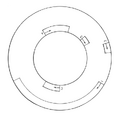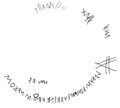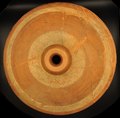VB·3.3: Difference between revisions
No edit summary |
No edit summary |
||
| (7 intermediate revisions by the same user not shown) | |||
| Line 1: | Line 1: | ||
{{inscription | {{inscription | ||
|reading=lutou: | |reading=lutou:unknown!iii | ||
|reading_lepontic={{c| | |reading_lepontic={{c|I}}{{c|I|I3|d}}{{c|I|I3|d}}{{c|separator|separator2}}{{c|U}}{{c|O|O3}}{{c|T}}{{c|U}}{{c|L}} | ||
|direction=sinistroverse | |direction=sinistroverse | ||
|letter_height_min=0 | |letter_height_min=0.7 cm | ||
|letter_height_max=1.2 cm | |||
|letter_number_min=5 | |letter_number_min=5 | ||
|word_number=1 | |||
|word_number= | |||
|line_number=1 | |line_number=1 | ||
|corpus=Cisalpine Celtic | |corpus=Cisalpine Celtic | ||
| Line 18: | Line 17: | ||
|condition=complete | |condition=complete | ||
|type_inscription=unknown | |type_inscription=unknown | ||
|language= | |language=Celtic | ||
|meaning= | |linguistic_ascription=prob. | ||
|meaning='Lutou ...' | |||
|whatmough=304 | |whatmough=304 | ||
|tibiletti_bruno=10 | |tibiletti_bruno=10 | ||
| Line 26: | Line 26: | ||
|source_detail=Morandi 2004: 550–552 no. 48 B2 | |source_detail=Morandi 2004: 550–552 no. 48 B2 | ||
|checklevel=1 | |checklevel=1 | ||
|problem= | |problem=literature | ||
|disambiguation=VB·3 | |disambiguation=VB·3 | ||
}} | }} | ||
==Commentary== | ==Commentary== | ||
First published in | First published in {{bib|Bianchetti 1895}}: 69 f. (no. 21). Examined for LexLep on 20<sup>th</sup> April 2024. | ||
Images in {{bib|Lejeune 1987}}: pl. XIIIb (photo = {{bib|Solinas 1995}}: tav. LXX d and b), {{bib|Morandi 2004}}: 566, fig. 12.48 (drawing). | Images in {{bib|Lejeune 1987}}: pl. XIIIb (photo = {{bib|Solinas 1995}}: tav. LXX d and b), {{bib|Piana Agostinetti 1972}}: tav. XXXI.12 (drawing), {{bib|Graue 1974}}: Taf. 30.3 (drawing), {{bib|Caramella & De Giuli 1993}}: tav. LXXVII.2 (drawing), {{bib|Morandi 2004}}: 566, fig. 12.48 (drawing). | ||
{{bib|Kretschmer 1905}}: 99, no. 21 | Inscribed on the opposite side of [[VB·3.2]], below the innermost of the white bands (length 4 cm). The letters, particularly the first upsilon and omicron, are scraggly, but neat. After the sequence {{w||lutou}} follows a separator of two dots, two oblique lines and one straight line. The lines after the separator were read as {{c||U}}{{c||I}} ''iu'' by Bianchetti (also {{bib|Kretschmer 1905}}: 99, no. 21, {{bib|Rhŷs 1913}}: 62, no. 20 (c), {{bib|Whatmough 1933}}: 111–113, no. 304 (c), {{bib|Tibiletti Bruno 1978}}: 144, 146, {{bib|Tibiletti Bruno 1981}}: 162–164, no. 10), while {{bib|Lejeune 1987}}: 497 identified them as "symboles" (thus implicity also {{bib|Morandi 2004}}: 550–552 no. 48 B1, who reads {{w||lutou}}). Negligible {{bib|Solinas 1995}}: 375, no. 128 3, who includes a spot of surface damage as an additional separator (''lutou:i:u''). Since the last two lines do not meet at the bottom, we agree with Lejeune. The function of the lines after the separator is unclear. | ||
{{bib|Pisani 1964}}: 286 f., no. 124 (b), who seems to have worked with Whatmough's inaccurate drawing of the inscriptions' placement on the flask, considered the four short inscriptions on the vase to form a sentence ''etninou.ealutou:iutuni:'', separated for aesthetic reasons. Rather more plausible is Rhŷs' and Lejeune's ({{bib|Lejeune 1987|1987}}: 497) assumption that all the sequences are abbreviations of personal names; {{bib|Morandi 1999}}: 172, no. 17 suggests that they record the names of the gift givers ("sottoscrizioni" in {{bib|Morandi 2004|2004}}: 552). The sequence {{w||lutou}} may indeed be a personal name (or possibly abbreviation); see the word page for comparanda in the corpus. ⟨ou⟩ appears to denote long /{{p||ū}}/ (see the word page). Cf. especially [[VB·3.2]] {{w||inou}}:{{w||ea}}, which is applied directly opposite the present inscription. | |||
See also {{bib|Lattes 1896}}: 106 f., n. 16, {{bib|Giussani 1902}}: 55 f., {{bib|Piana Agostinetti 1972}}: 272, no. 12, '''{{bib|Morandi 1999b}}: 308–312, no. 4'''. | |||
<p style="text-align:right;>[[User:Corinna Salomon|Corinna Salomon]]</p> | |||
{{bibliography}} | {{bibliography}} | ||
Latest revision as of 17:58, 29 October 2024
| Inscription | |
|---|---|
| Reading in transliteration: | lutou : iii |
| Reading in original script: | |
|
| |
| Object: | VB·3 Ornavasso (bottle) (Inscriptions: VB·3.1, VB·3.2, VB·3.3, VB·3.4, VB·3.5) |
| Position: | shoulder, outside |
| Orientation: | 0° |
| Direction of writing: | sinistroverse |
| Script: | North Italic script (Lepontic alphabet) |
| Letter height: | 0.7–1.2 cm0.276 in <br />0.472 in <br /> |
| Number of letters: | 5 |
| Number of words: | 1 |
| Number of lines: | 1 |
| Workmanship: | scratched after firing |
| Condition: | complete |
|
| |
| Archaeological culture: | La Tène D [from object] |
| Date of inscription: | first half of 1st c. BC [from object] |
|
| |
| Type: | unknown |
| Language: | prob. Celtic |
| Meaning: | 'Lutou ...' |
|
| |
| Alternative sigla: | Whatmough 1933 (PID): 304 Tibiletti Bruno 1981: 10 Solinas 1995: 128 3 Morandi 2004: 48 B2 |
|
| |
| Sources: | Morandi 2004: 550–552 no. 48 B2 |
Images
|
| ||||
Commentary
First published in Bianchetti 1895: 69 f. (no. 21). Examined for LexLep on 20th April 2024.
Images in Lejeune 1987: pl. XIIIb (photo = Solinas 1995: tav. LXX d and b), Piana Agostinetti 1972: tav. XXXI.12 (drawing), Graue 1974: Taf. 30.3 (drawing), Caramella & De Giuli 1993: tav. LXXVII.2 (drawing), Morandi 2004: 566, fig. 12.48 (drawing).
Inscribed on the opposite side of VB·3.2, below the innermost of the white bands (length 4 cm). The letters, particularly the first upsilon and omicron, are scraggly, but neat. After the sequence lutou follows a separator of two dots, two oblique lines and one straight line. The lines after the separator were read as ![]()
![]() iu by Bianchetti (also Kretschmer 1905: 99, no. 21, Rhŷs 1913: 62, no. 20 (c), Whatmough 1933: 111–113, no. 304 (c), Tibiletti Bruno 1978: 144, 146, Tibiletti Bruno 1981: 162–164, no. 10), while Lejeune 1987: 497 identified them as "symboles" (thus implicity also Morandi 2004: 550–552 no. 48 B1, who reads lutou). Negligible Solinas 1995: 375, no. 128 3, who includes a spot of surface damage as an additional separator (lutou:i:u). Since the last two lines do not meet at the bottom, we agree with Lejeune. The function of the lines after the separator is unclear.
iu by Bianchetti (also Kretschmer 1905: 99, no. 21, Rhŷs 1913: 62, no. 20 (c), Whatmough 1933: 111–113, no. 304 (c), Tibiletti Bruno 1978: 144, 146, Tibiletti Bruno 1981: 162–164, no. 10), while Lejeune 1987: 497 identified them as "symboles" (thus implicity also Morandi 2004: 550–552 no. 48 B1, who reads lutou). Negligible Solinas 1995: 375, no. 128 3, who includes a spot of surface damage as an additional separator (lutou:i:u). Since the last two lines do not meet at the bottom, we agree with Lejeune. The function of the lines after the separator is unclear.
Pisani 1964: 286 f., no. 124 (b), who seems to have worked with Whatmough's inaccurate drawing of the inscriptions' placement on the flask, considered the four short inscriptions on the vase to form a sentence etninou.ealutou:iutuni:, separated for aesthetic reasons. Rather more plausible is Rhŷs' and Lejeune's (1987: 497) assumption that all the sequences are abbreviations of personal names; Morandi 1999: 172, no. 17 suggests that they record the names of the gift givers ("sottoscrizioni" in 2004: 552). The sequence lutou may indeed be a personal name (or possibly abbreviation); see the word page for comparanda in the corpus. ⟨ou⟩ appears to denote long /ū/ (see the word page). Cf. especially VB·3.2 inou:ea, which is applied directly opposite the present inscription.
See also Lattes 1896: 106 f., n. 16, Giussani 1902: 55 f., Piana Agostinetti 1972: 272, no. 12, Morandi 1999b: 308–312, no. 4.
Bibliography
| Bianchetti 1895 | Enrico Bianchetti, I sepolcreti di Ornavasso [= Atti della Società di Archeologia e Belle Arti della provincia di Torino 6], Torino: Paravia 1895. |
|---|---|
| Caramella & De Giuli 1993 | Pierangelo Caramella, Alberto De Giuli, Archeologia dell'Alto Novarese, Mergozzo: Antiquarium Mergozzo 1993. |





